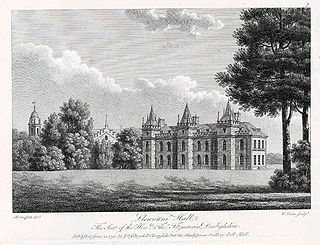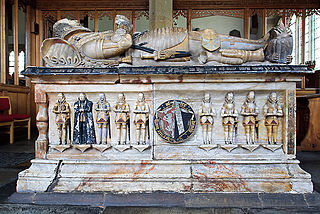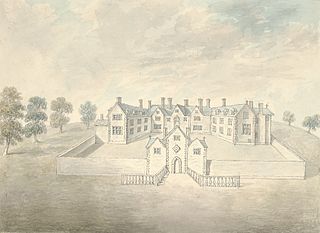
Hester Lynch Thrale Piozzi, a Welsh-born diarist, author and patron of the arts, is an important source on Samuel Johnson and 18th-century English life. She belonged to the prominent Salusbury family, Anglo-Welsh landowners, and married first a wealthy brewer, Henry Thrale, then a music teacher, Gabriel Mario Piozzi. Her Anecdotes of the Late Samuel Johnson (1786) and her diary Thraliana, published posthumously in 1942, are the main works for which she is remembered. She also wrote a popular history book and a dictionary. She has been seen as a protofeminist.

Henry Stanley, 4th Earl of Derby KG was a prominent English nobleman, diplomat, and politician. He was an ambassador and Privy Counsellor, and participated in the trials of Mary, Queen of Scots and the Earl of Arundel.
The Salusbury family is an Anglo-Welsh family notable for their social prominence, wealth, literary contributions and philanthropy.
Sir Thomas Myddelton was a Welsh merchant who was Lord Mayor of London before becoming a Member of Parliament for London.

Sir Thomas Salisbury was one of the conspirators executed for his involvement in the Babington Plot.

Sir Richard Clough, known by his Welsh contemporaries as Rhisiart Clwch, was a merchant from Denbigh, north-east Wales, and an agent of Queen Elizabeth I of England.

Lleweni Hall was a stately home in Denbighshire, northeast Wales, around 2 miles (3.2 km) north-east of Denbigh on the banks of the River Clwyd. It was the principal seat of the Salusbury family and their descendants from 1289 until 1748, and the present territorial designation of the most senior branch of the family.
Sir John Salusbury was a Welsh nobleman, explorer and co-founder of Halifax, Nova Scotia. He is credited as being one of the founders of modern Canada along with several other members of his expedition, including the Earl of Halifax and Edward Cornwallis. He served on the Nova Scotia Council throughout Father Le Loutre's War. He participated in the Battle at Chignecto. His diaries regarding the military campaign to establish a colony in Nova Scotia on behalf of the British Government became a vital source of information regarding the hardships, difficulties and opposition from the average Englishman regarding the development of the colony. He was a direct descendant of Katheryn of Berain.
Sir William Williams, 2nd Baronet, of Glascoed, Llansilin, Denbighshire was a Welsh landowner and Tory politician who sat in the House of Commons from 1708 to 1710.
This article is about the particular significance of the century 1501–1600 to Wales and its people.

There have been two baronetcies created for members of the Salusbury family, the first in the Baronetage of England and the second in the Baronetage of Great Britain. Neither title has survived to the present day although the senior baronetcy is technically considered to be dormant.

The first High Sheriff of Denbighshire was John Salusbury, snr, appointed in 1540. The shrievalty of Denbighshire, together with that of Flintshire, continued until 1974 when it was abolished after the county and shrievalty of Clwyd was created.

Sir Thomas Salusbury, 2nd Baronet was a Welsh poet, politician and soldier, who supported King Charles I in English Civil War and was a colonel of a Royalist regiment.

Sir John Salusbury was a Welsh knight, politician and poet of the Elizabethan era. He is notable for his opposition to the faction of Robert Devereux, 2nd Earl of Essex, and for his patronage of complex acrostic and allegorical poetry that anticipated the Metaphysical movement.
Events from the year 1748 in Wales.
Maurice Wynn or Morys Wynn ap John of Gwydir was a Welsh courtier and politician.
Sir Roland de Velville was a Breton-born English soldier and government official who is theorised as the illegitimate son of King Henry VII of England by "a Breton lady whose name is not known", or as a favoured member of the court of Henry VII and later recipient of beneficences, brought home to England with 28-year-old Henry after his exile in Brittany, an adolescent "of unknown parentage", and so a possible or likely illegitimate son, with formal historical opinion undecided.

John Salusbury, of Lleweni Hall, Denbighshire, was a Welsh landowner, county officer, and member of parliament.

Simon Thelwall was a Welsh Member of Parliament.

Nantclwyd Hall is a 17th-century Grade II* listed mansion near the village of Llanelidan, Denbighshire, Wales, built by the Parry family, and rebuilt by Eubule Thelwall and his wife Mary Parry, the heiress of the estate.












